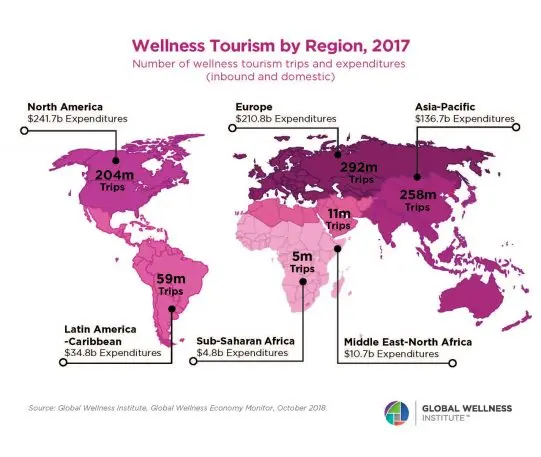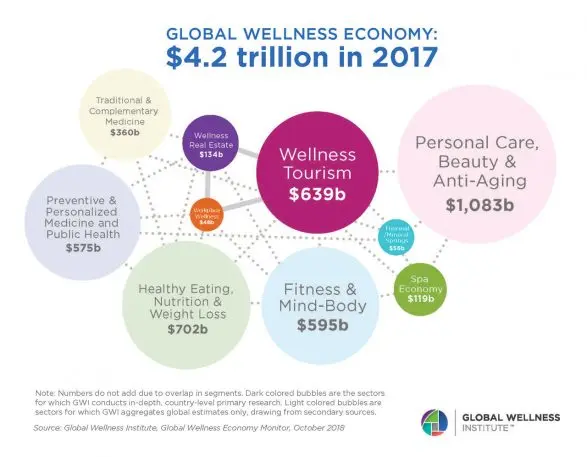Poke fun at goat yoga all you want, but don’t underestimate the booming wellness industry.
The Global Wellness Institute (GWI) said this weekend that the wellness market, which encompasses everything from boutique fitness gyms to day spas, is now valued at a whopping $4.2 trillion, having grown 12.8% in the last two years. The industry now represents 5.3% of global economic output.
“As people incorporate more of the wellness values into their lifestyle, our interaction with the wellness economy is also becoming less episodic and more intentional, more integrative, and more holistic,” GWI senior research fellow Ophelia Yeung said during a presentation Saturday at the Global Wellness Summit held in Cesena, Italy. “In the last few years, wellness has become a dominant lifestyle value that is profoundly changing consumer behavior and changing the markets.”

- Personal care and beauty: $1.082 trillion
- Healthy eating, nutrition and weight loss: $702.1 billion
- Wellness tourism: $639.4 billion
- Fitness / mind-body: $595.4 billion
- Preventive and personalized medicine and public health: $574.8 billion
- Traditional and complementary medicine: $359.7 billion
- Wellness real estate: $134.3 billion
- Spa economy: $118.8 billion
- Thermal / mineral springs: $56.2 billion
- Workplace wellness: $47.5 billion
Spas, tourism, and real estate were shown to be the fastest-growing sectors in the last two years. Wellness real estate, as Fast Company previously reported, influenced the U.S. market in the last few years, with developers increasingly investing in neighborhoods and properties dedicated to holistic health. According to the 2018 Global Wellness Economy Monitor, there are more than 740 wellness estate and community developments either built or in the works across 34 countries. It’s projected to grow 8% in the next five years, reaching over $197 billion by 2022.
The spa economy also saw a dramatic increase as more consumers find themselves drawn to self-care oases in the wake of hectic, over-connected lifestyles. Since 2007, the number of spas doubled from 71,000 to 149,000, producing 2.6 million employment opportunities in the global spa industry. The thermal/mineral springs market, much like the lucrative bath economy, also grows stronger as women turn to warm water for stress relief.

“A fitness company now is competing with different brands in the hospitality sector–that’s not something we were seeing just five years ago,” explained Yeung. “We’re going to see more and more wellness creeping into what we think is generic type of spending.”
Last week, Equinox announced fitness and wellness getaways in a bid to woo Americans looking to “reset” during their (limited) time off. It joins other recent hospitality hybrids: Westin Hotels partnered with Peloton, Fairmont with Reebok and Technogym, while Hyatt acquired boutique fitness and wellness brand Exhale.
In 2017, travelers took 830 million wellness trips–139 million more than in 2015. As one of the fastest-growing travel trends, wellness travel currently represents 17% of total tourism expenditures.

“In the face of longer lifespans, and rising chronic disease, stress and unhappiness, we only see growth for wellness ahead,” said Yeung in a press statement. “We believe that the three sectors that represent the core spheres of life will see the strongest future growth–wellness real estate, workplace wellness and wellness tourism–while other sectors will also grow as they support the integration of wellness into all aspects of daily life. And wellness markets will become less siloed and more interconnected, converging to offer solutions and experiences in the places where people live, work and travel.”
Beyond the Goop set
Wellness, in its many mutable forms, is often viewed as a luxury commodity, mostly accessible to the wealthy or avid Goop readers. During the three-day Global Wellness Summit, 650 industry leaders, government representatives, and entrepreneurs addressed not only the issues surrounding exclusivity, but solutions on how to utilize wellness for the masses. How can companies and public health officials ensure health practices reach lower income communities? Can wellness better address chronic health issues and fill in the gaps left by traditional healthcare? How can we utilize technology to better serve our physical and mental well-being?
Such pressing issues loom in the face of dismal statistics: Healthcare costs are rising faster than GDP in most developed countries, and the World Health Organization predicts a shortfall of 18 million health workers by 2030. Most non-communicable diseases, however, are preventable through proper nutrition, exercise, and lifestyle habits.
The wellness economy is more than half the size of all global health spending, which was last estimated at $7.3 trillion. (The United States currently spends more than other developed countries on healthcare, but somehow has poorer outcomes.)
While certain aspects of wellness, such as fitness, have become more affordable and accessible (like, say, $10 gym memberships and class apps), the GWI team finds the incremental shift from private to public health the most promising. As wellness grows in popularity, it seeps into the public consciousness, and eventually (or rather, hopefully), public policy. It’s not the medical side where wellness industries could prove themselves most useful, rather it’s the preventative side.
As Yeung stressed, “We’re a getting to the point where the whole wellness economy–the economy part–has to start engaging with the public part.”
Recognize your brand’s excellence by applying to this year’s Brands That Matter Awards before the early-rate deadline, May 3.
